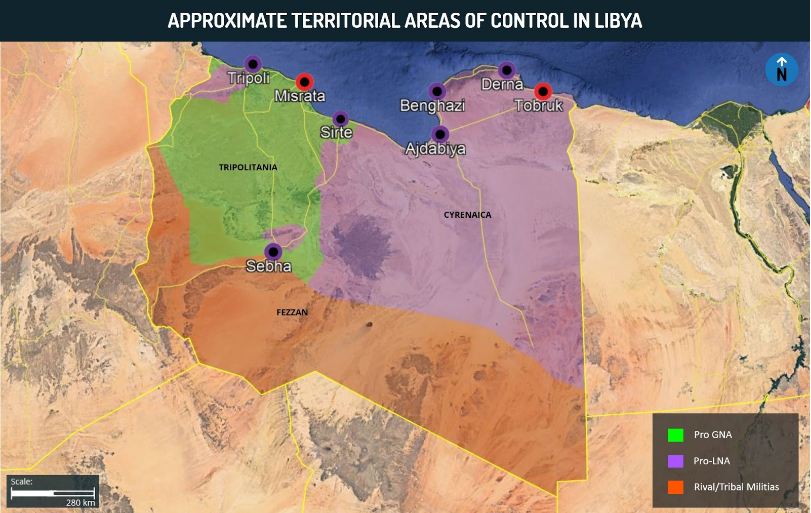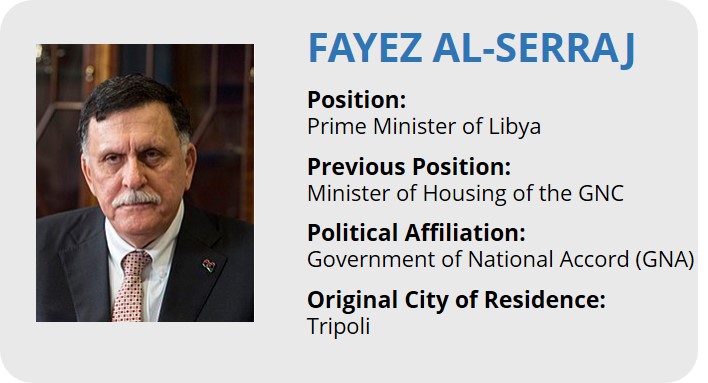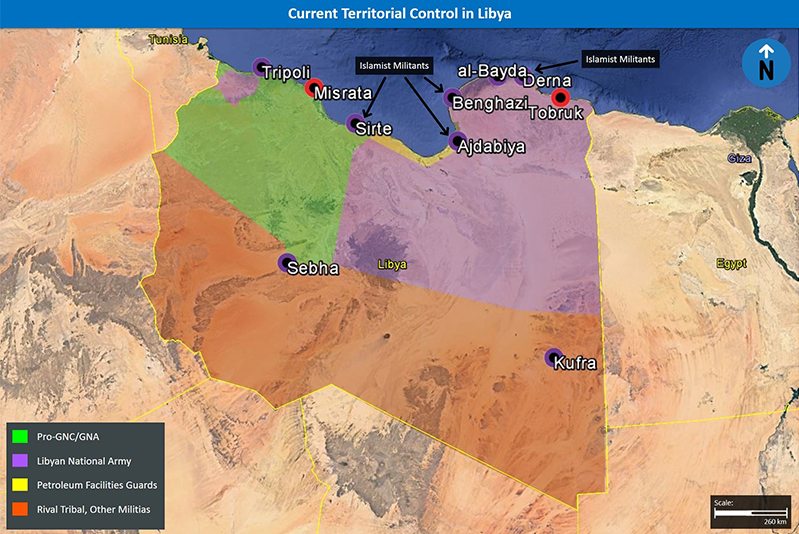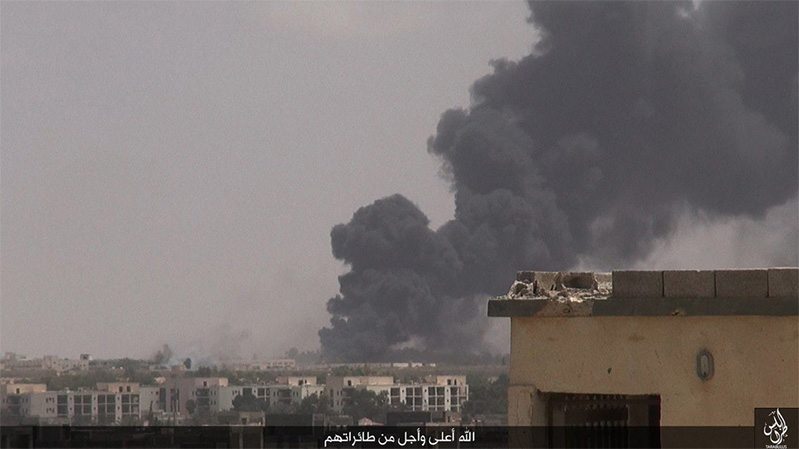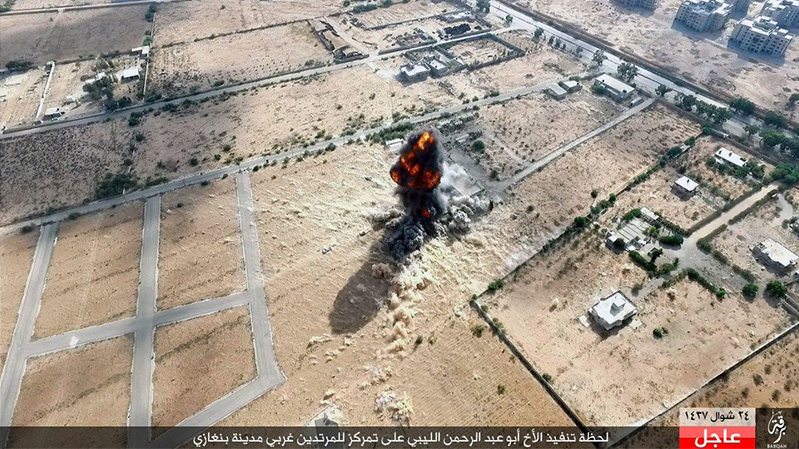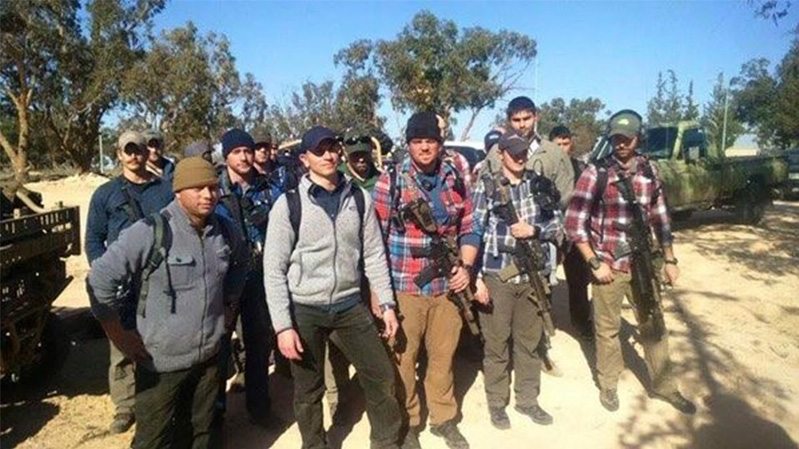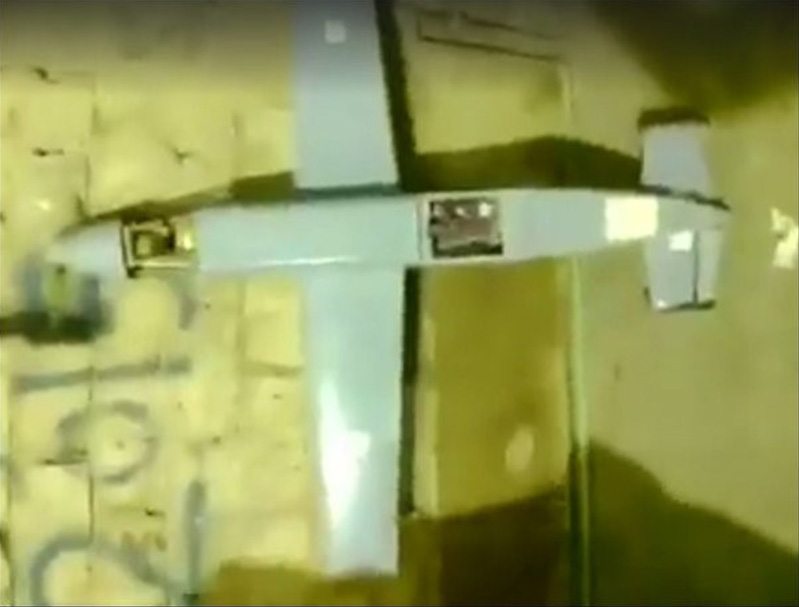This report was written by: Akshita Aggarwal – MAX Security’s Associate Director of Intelligence, Middle East & North Africa
And reviewed by: Tzahi Shraga – MAX Security’s Chief Intelligence Officer, ret. LTC from the Israeli intelligence community
Oded Berkowitz – MAX Security’s Deputy Chief Intelligence Officer
Executive Summary
Control over territory in Libya remains contested between the House of Representatives (HoR), the Government of National Accord (GNA), and tribal militias. As neither of these entities are willing to compromise upon their interests, the current political landscape in Libya will remain unstable.
Multiple militias with rival territorial, economic, political, and ideological interests operate in the country. As there is often no clear demarcation between their respective areas of influence, sporadic armed clashes between these groups will continue over the coming months.
Militant groups continue to take advantage of the lack of a unified security apparatus to operate across Libya. Although these groups currently do not have the ability to regain territorial control in the country, the sophistication and scale of their attacks will increase over the coming months.
The Libyan economy is largely dependent upon the oil industry. The ongoing political and security instability will continue to deprive the government of the ability to invest in development and infrastructure, as well as protect oil facilities from potential militant attacks.
Overall, the security environment in Libya remains extremely volatile and is set to further deteriorate in the foreseeable future.
Download the 2019 Global Travel Risk Map now.
Background
Multiple political and armed actors are currently operating across Libya. In many cases, there is no clear territorial demarcation between their respective spheres of influence, and therefore, at times these tend to overlap. The fringes of these territories also provide a conducive environment for the proliferation of militant groups, such as the Islamic State (IS), as well as local and foreign criminal militias. Moreover, internal divisions exist even within seemingly cohesive political factions and armed units, due to differing interests and ideologies, which contribute to the already volatile security environment in the country.
The overarching geographical areas of control are as follows:
Western Libya: Largely under the control of militias aligned with the UN-backed Government of National Accord (GNA). However, the majority of these militias have rival economic and territorial interests, which often lead to hostilities between them.
Eastern Libya: Largely controlled by the House of Representatives (HoR) and its allied Libyan National Army (LNA).
Southern Libya: Largely ungoverned territory, with rival tribal militias in control of isolated towns and production facilities. Although the LNA managed to recently extend its influence over parts of southern Libya, tribal militias in control of the town hold shifting allegiances.
Main Actors & Interests
The Government of National Accord (GNA): The GNA is based out of the Tripoli Naval Base and is a product of the Libyan Political Agreement (LPA), signed in Skhirat, Morocco in December 2015. The LPA allows for the transition of the House of Representatives (HoR) and the General National Congress (GNC) into the GNA’s legislative body and advisory State Council, respectively. However, this transition was to be ratified by a special majority vote of the HoR within a period of one year, which was renewable only once. The HoR is yet to convene the needed quorum for this vote. On December 17, 2017, the Libyan National Army (LNA) Field Marshal Khalifa Haftar declared that “All bodies resulting from this agreement [LPA] automatically lose their legitimacy, which has been contested from the first day they took office.” Regardless, the GNA continues to be considered the “internationally recognized” government and enjoys the support of the UN. Its sphere of influence extends through western Libya, particularly in greater Tripoli and Misrata.
House of Representatives (HoR): The previously “internationally recognized” government, the HoR’s parliament is based in Tobruk and the executive branch in al-Bayda. Its sphere of influence is generally in eastern Libya, with some pockets of support in the west, particularly southwest of Tripoli. The HoR is currently supported politically, militarily, and economically by several countries, most prominent of whom are France, the United Arab Emirates (UAE), and Egypt. While these countries generally recognize and support the LPA, they capitalize on the fact that the HoR has not ratified the agreement as a pretext to consider it as non-valid at this time, in order to continue supporting the HoR and not the GNA.
Other groups: Both the ungoverned and the governed areas of Libya are dominated by politics based on tribal, clan, and ethnic backgrounds, as well as place of residence and origin. It is not uncommon for cities that both support the same political body to be at odds due to historical or other rivalries among their residents. Similarly, militias from the same city who support the same political organ may have a strife over tribal or other rivalries.
Armed Groups
The GNA is currently almost completely reliant on local armed militias to exert influence over its territories. The most prominent GNA-linked militia are the Misrata forces, based out of the northwestern town of Misrata. Misrata forces also maintain their own air force, which was initially formed in 2015 as the Libya Dawn Air Force (LDAF), and later in 2016, aligned itself with the GNA. Misrata has very few operational pilots and aircraft, which were most recently operationally used in 2016 in hostilities against the LNA and the Islamic State (IS). Several other militias, like the al-Radaa Special Deterrence Forces, the Abu Salim Battalion, and the Tripoli Revolutionaries’ Brigade, are formally under the command of the GNA’s Ministry of Defense (MoD), and hold territorial control over different parts of Tripoli.
The Libyan National Army (LNA) and its allied militias are led by Supreme Commander Field Marshal Khalifa Haftar. The LNA is allied with the HoR, based out of Tobruk. It has a clearer command and control structure, with several commanders in charge of different battalions and areas of LNA-controlled territories. Although the majority of LNA forces are anti-Islamist, certain factions within the forces hold a Salafist ideology. Presently, the LNA’s main area of operations is in and around the Oil Crescent, Jufra District, Fezzan Region, Kufra District, Benghazi, Derna, and Tobruk. It also has some influence in areas southwest of Tripoli through their association with Zintan-based militias. The LNA also maintains an air force, the Libyan Air Force (LAF). LAF aircraft are used primarily to conduct aerial reconnaissance and airstrikes against militant and militia convoys in the Sirte Basin and Fezzan Region.
Tribal militias, mostly consisting of either Tebu or Tuareg ethnic tribes, control most of southern Libya, including Sebha. These tribes are at times supported by fellow tribesman from neighboring countries, such as Chad and Sudan. They hold shifting allegiances towards the various players in the country.
Islamist militant groups, such as the Islamic State (IS) as well as the al-Qaeda-linked Revolutionary Shura Council of Benghazi (RSCB), Derna Protection of Force (DPF), and Saraya Defend Benghazi (SDB), continue to operate across Libya. The IS and the SDB are currently the most prominent of these groups.
Political Stability
The efforts of the Head of the UN Special Mission to Libya (UNSMIL), Ghassan Salame, over the past year have at least partly prompted the HoR and the GNA to work towards unification of all institutions in the country and end the ongoing political stalemate. The HoR approved the referendum law on September 14, which allows for a referendum on Libya’s draft constitution. Subsequently, in November, the HoR successfully voted on a constitutional amendment, which legally validates the referendum law. It also divides the country into three constituencies – Tripolitania, Cyrenaica, and Fezzan. According to the amendment, the approval of the draft constitution would require an absolute majority vote in each region as well as a two-thirds majority vote nationwide. At the same time, the HoR approved the restructuring of the Presidential Council (PC), whose membership will now reduce from nine to three. It will now be consist of a President and two deputies, and a separate Prime Minister as the Head of the government.
Assessments & Forecast: Recent measures aimed at unifying political institutions unlikely to lead to nationwide elections
While on paper, the aforementioned developments portray that the GNA and the HoR have made substantial progress towards a nationwide election process and the unification of political institutions in the country, these measures have substantially tilted the scales in favor of the latter. Members of the GNA had previously opposed the amendment of Article 6 of the LPA, which divides Libya into three distinct constituencies as well as the restructuring of the PC. If the constitutional referendum does not pass, the current law assigns Cyrenaica with a veto power, which would essentially allow the HoR to activate an article of the referendum law that would pass on the responsibility of drafting the new constitution to the HoR, thus allowing the eastern-based government to alter Article 8 of the LPA.
Article 8 of the LPA has been a highly controversial point between the GNA and the HoR. This article excludes anyone with dual citizenship from holding either a political or military post in the country. LNA Field Marshal Khalifa Haftar holds both US and Libyan citizenship, and therefore, this will exclude him from Libya’s future political landscape. The HoR’s insistence on amending this article stems from the fact that it currently extends territorial influence over eastern Libya due to its alliance with the LNA. Moreover, the LNA is in control of much of Libya’s oil infrastructure, which has gained Haftar increasingly international legitimacy over the past year, as underlined by his inclusion in both the Paris Conference in May and the Palermo Conference in November.
FORECAST: These conditions provide the HoR with an upper hand in negotiations, and therefore, it is unlikely to concede to the GNA on any key issues pertaining to the country’s future. Such a scenario will provide France with significant influence over Libyan politics vis-a-vis its regional rival, Italy. Therefore, both countries will attempt to intervene in Libya in order to ensure a more favorable outcome for themselves. This, in conjunction with the lack of electoral infrastructure, will further delay the slated March 2019 nationwide election process. If and when elections do take place, the turnouts will be very low due to the inability of either the GNA or the HoR to provide the required security to secure electoral booths from the threat of militancy. Moreover, as Libya is based on tribal culture, with a council of elders responsible for governing each town, any federally constituted government will face resistance on the local level.
Threat of Militancy
Islamic State (IS): Although IS does not control any territory in Libya as of December 2016, it has managed to rebuild some of its capabilities in the country over the past year. Initially, the majority of IS attacks were directed against LNA checkpoints in the Sirte Basin and Jufra District, which mainly utilized vehicle-borne IEDs (VBIEDs). Gradually, IS shifted towards conducting more sophisticated multi-pronged attacks against government infrastructure in western Libya. For example, IS claimed multi-pronged attacks against the Misrata Courts Complex on October 4, 2017, against the Tripoli Electoral Commission on May 2, 2018, and the National Oil Corporation (NOC) Headquarters in Tripoli on September 10, 2018. And finally, IS militants launched two large-scale attacks against the towns of al-Fuqaha, Jufra District, and Tazirbu, Kufra District, on October 28 and November 23, respectively.
Saraya Defend Benghazi (SDB): In June 2017, the SDB indicated its willingness to disband after Misrata forces refused to provide them refuge in the city of Misrata, following the former’s loss all its territories in the Jufra District to the LNA. While reports did indicate that SDB fighters were still operating in parts of western and southern Libya, the group remained dormant for approximately a year. However, in June 2018, SDB fighters, led by the former Petroleum Facilities’ Guard (PFG) commander Ibrahim al-Jathran, launched a large-scale attack against the Ras Lanuf and Sidra oil terminals, located in the Oil Crescent. However, following the LNA’s recapturing of the Oil Crescent, the group has again gone dormant and not launched any significant attacks in Libya.
Assessments & Forecast: Although militant groups unlikely to regain territorial control in Libya, the sophistication of their attacks is likely to increase
Several factors have allowed militant groups to regain part of their ranks and capabilities in Libya over the past year. First, militants either planning to go fight for IS in Syria or Iraq, or fleeing the group’s territorial losses in these countries, view Libya as an alternative arena for their activity, and therefore have bolstered the ranks of the Sunni jihadist militant group in the country. Second, the LNA’s preoccupation in hostilities in other parts of the country, such as in Benghazi, Sebha, Derna, and the Sirte Basin, over the past year likely allowed militants to regroup in southern Libya, which remains largely controlled by tribal militias, without being detected by security forces. Third, widespread cross-border smuggling of weapons and fighters across Libya’s southern borders with Sudan and Chad, likely allowed both IS and the SDB to reinforce their offensive capabilities.
While both groups continue to remain interested in destabilizing the security environment in the country, neither of the groups currently maintain the ability to regain a territorial foothold in Libya. However, they do have the capability to launch attacks against more high-value targets, such as government offices, oil, and other infrastructure, in Libya. The lack of sufficient security protocols around these facilities allows the groups’ fighters to circumvent existing measures to gain access to their interiors. Such attacks allow militant groups to not only project their heightened capabilities to attract support and recruits, but also deprive the authorities of the necessary revenues to invest in their counter-militancy campaign. Aside from this, IS’s particularly increased focus on attacking towns in southern Libya are part of an attempt by the group intimidate locals and gain ransom from kidnappings at the same time. Overall, all these efforts are directed towards further destabilizing the security environment in the country, with the ultimate aim of expanding influence and re-establishing a territorial foothold.
FORECAST: Despite efforts by both the LNA and GNA-linked militias to dislodge militancy from the country, both IS and the SDB will continue to utilize the vast desert terrain of southern Libya as well as the fringes between GNA and LNA-held territories to regroup and rebuild their capabilities. They will the use these bases as launchpads for further attacks against government and security installations. The sophistication of these attacks may gradually increase as the militant groups attempt to launch more symbolic operations. The lack of a unified security apparatus, combined with insufficient military equipment and training, will overstretch the LNA and local militias, which will continue to hinder their ability to effectively combat this threat of rising militancy in Libya.
Economic Stability
The Libyan economy is largely dependent upon the export of oil. Oil production facilities are operated by foreign companies, with permission from the National Oil Corporation (NOC), based in Tripoli. The oil revenues then accrue to the Central Bank of Libya (CBL), based in Tripoli, which then distributes the revenue to the GNA, the HoR, the LNA, and GNA-aligned militias.
Assessments & Forecast: Political divisions, security volatility, global oil prices unlikely to significantly increase government revenues
Tensions have persisted between the GNA and the HoR regarding control have over Libya’s monetary policy and revenues, which prompted both parties to form parallel central banks based in Tripoli and al-Bayda in 2014. After retaking control of the Ras Lanuf and Sidra oil terminals from the SDB in June 2018, Haftar decided to hand over control of revenue from these oil terminals to the eastern-based NOC. However, in 2017, when PFG commander Ibrahim al-Jadhran temporarily took control of the Oil Crescent and attempted to directly sell the oil from these facilities on the international market, European countries imposed an embargo on this oil. They further stated that only oil bought from the Tripoli-based NOC would be considered as legal. Therefore, Haftar’s decision was likely prompted by an attempt to not undermine the Tripoli-based NOC, whose head Mustafa Sanalla, is popular both among the GNA and the HoR, but rather to force the GNA to replace the CBL head, Sadiq al-Kabir, whom the LNA considers as corrupt and illegitimate. This is supported by the fact that Haftar eventually agreed to hand over control of revenue from the oil terminals back to the Tripoli-based NOC on July 10. The underlines the divisions instability arising from the bipolarity between the country’s economic institutions.The widespread threat of militancy, as well as militia activity, poses a further threat to oil infrastructure in the country. The majority of these facilities are secured by local militias who have their own interests in mind.
Therefore, they often utilize these facilities as bargaining chips in their negotiations with the GNA. For example, in recent weeks, a movement under the name “Anger of Fezzan” threatened the Sharara Oil Field if their demands for development in southern Libya were not met. Moreover, the militiamen who are in charge of securing oil fields are neither well-equipped nor well-trained, and therefore are usually incapable of protecting these facilities from a well-executed attack. Oil pipelines in the country tend to run across territories held by different militias with rival interests which pose a further threat to business continuity. This, combined with the instability of global oil prices, makes Libya’s economy highly unpredictable and unstable for the foreseeable future.
FORECAST: As the aforementioned political and security issues will persist for the foreseeable future, Libya’s economy is unlikely to witness any form of stability. This will adversely impact the GNA’s already declining popularity in the country. July witnessed widespread anti-GNA protests in Tripoli and its surroundings over the UN-backed government’s inability to provide locals with water and electricity. These eventually provided local militias with conditions conducive to launch an assault against each other in order to advance their personal territorial interests, thereby sparking large-scale inter-militia hostilities in the designated capital. Therefore, an unstable economy will lead to civil unrest in the future, which, in turn, will increase the threat posed by militant groups and armed militias.
Infrastructure & Development
Political, security, and economic stability have a direct impact on the prospects for infrastructure and development.
Assessments & Forecast: Economic, political, security instability to prevent the government from investing in development, infrastructure
The lack of sufficient revenue has denied the GNA and the LNA with the ability to invest in development and infrastructure. Airports in Libya are generally controlled by local militia groups, who are under-trained and under-equipped to employ proper security protocols for air travel. This includes the lack of a secure perimeter around airports, which allows militias and militant groups to use weapons of relatively lower sophistication to target these facilities. This is highlighted by the frequent mortar shelling of the Mitiga International Airport as a result of inter-militia hostilities in Tripoli. The GNA has also been unable to reopen the Tripoli International Airport as militias frequently attempt to take control of the facility from their rivals. Aside from attacks, service disruptions at airports remain frequent due to staff strikes, particularly over unpaid salaries. This is due to the lack of sufficient funds under the control of the GNA, as it depends largely on the country’s oil reserves.
Commercial ports are also susceptible to attacks, as underscored by the temporary shut down of the Tripoli Seaport on October 17, 2017, due to clashes between GNA-linked militias near the facility. The majority of the country’s seaports are located in northwestern Libya. The Libyan Coastguard has frequently intercepted foreign vessels off the coast of northwest Libya on suspicions of illegal smuggling activity, as local militias in the area have been known to disguise as GNA officials to sell oil and fund their operations. With regards to seaports in eastern Libya, the LNA has been unable to fully operationalize the Benghazi and Derna ports following their capture from militants in June 2017 and May 2018, respectively. Moreover, the LNA Navy has designated Libyan territorial waters off the coast of Benghazi as a “no-sail” zone (until al-Tamimi, 280 km east of Benghazi), and therefore entering it requires prior authorization. This is particularly important as vessels that do not obtain such authorization and escort from the LNA Navy are automatically suspected of carrying support for militants, and may be intercepted or even targeted by airstrikes.
FORECAST: The lack of revenues will prevent the GNA and the LNA from substantially raising security protocols at infrastructural facilities in Libya. This will make such facilities an easy target for attacks by militant groups as well as militias. Militias operating in Tripoli and its environs will continue to attempt to seize control of vital airports and seaports in order to increase their negotiating power vis-a-vis their rivals. This will have an adverse impact upon operations at these facilities, even when militias try not to directly target them.
Recommendations
It is advised to defer all travel to Tripoli and Benghazi at this time due to ongoing violence, threats against foreigners, and the risk of a broad deterioration of security conditions. We advise at this time that those remaining in Tripoli and Benghazi should initiate contingency and emergency evacuation plans due to deterioration in the security situation. Contact us at [email protected] or +44 20-3540-0434 for itinerary and contingency support plans.
For those remaining in Tripoli, we advise avoiding nonessential travel to the outskirts of the city, particularly the Janzour and Tajoura neighborhoods, as well as to the Mitiga and Tripoli International Airports, given that these are focal points of ground clashes in the city.
Avoid all nighttime travel, including to and from the airport, due to the elevated risk for militant attacks, clashes, and acts of unrest during this time.
Travel to Misrata and Tobruk should be for essential purposes only while adhering to all security precautions regarding civil unrest and militancy. We advise against all travel to outlying areas of the country, due to the threat of militancy, kidnapping, and general lawlessness in such areas.
Avoid entering Libyan territorial waters in the area between Benghazi and al-Tamimi without prior authorization, as a no-sail zone is currently in effect in this area and several naval vessels had been intercepted or attacked due to not following proper procedures.
Those planning to conduct air travel to, from and inside Libya should avoid entering the area between Marsa al-Brega, Sirte and Sebha, as it was declared a no-fly zone by the Libyan National Army (LNA).
We further advise against all travel to Libya’s border areas at this time due to persistent violence and lawlessness in these regions.
For those operating in or conducting business with oil facilities, it is advised to consult with us for itinerary-based travel recommendations and ground support options.
Avoid the immediate vicinity of government buildings, police stations, media outlet offices, and political party and militia headquarters, given that these locales have been targeted by militia groups in the past and recently by militants, and thus remain at increased risk for violence and unrest.
Westerners, particularly US citizens, operating in Libya are advised to maintain a low profile and exercise heightened vigilance in light of prevailing anti-Western sentiment and increasing attacks against foreigners.
Nationwide, take precautions to mitigate the risk of being targeted for kidnapping. Refrain from travelling in luxury vehicles and maintain a generally low profile. Routinely alter travel routes and refrain from divulging sensitive itinerary information to strangers.
